Why Are Chatbots Important?
Are you wondering why the world is obsessed with chatbots? We'll dive deep into the data and break down the changing customer expectations here.
The problems with traditional online customer experiences
Just like any emerging technology, chatbots will only become widely adopted if it’s shown that they can solve real problems. Otherwise, the novelty will eventually wear off.
So in order to better understand where the opportunity lies for chatbots, we asked our 1,000+ survey participants to think about the online services they use today, such as search engines, messaging apps, product/service websites, and mobile apps.
Then we asked them: What frustrations have you experienced with these online services in the past month?
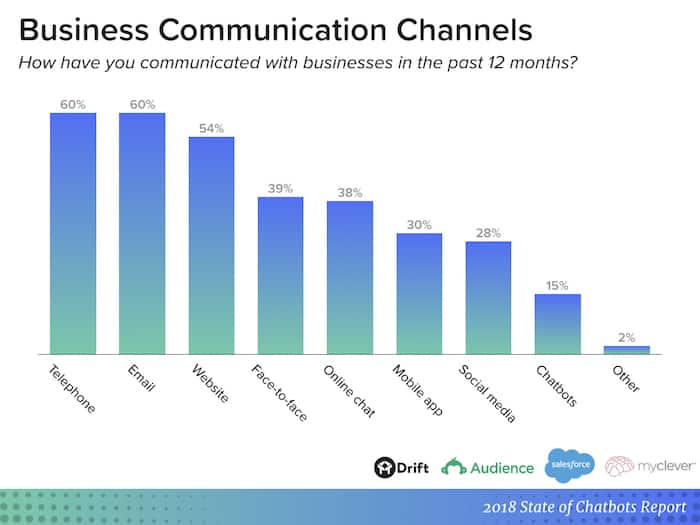
The most common frustrations reported by consumers included:
- Websites being hard to navigate (34%)
- Not being able to get answers to simple questions (31%)
- Basic details about a business — like address, hours of operations, and phone number — being hard to find (28%).
The takeaway: The online experiences businesses are providing no longer match the way people prefer to buy.
In the on-demand, real-time world we live in, where everything seems to be just one click away, consumers expect to be able to find the information they’re looking for quickly and easily. When they can’t, they get frustrated, and could end up turning to competitors who are providing the type of online experience they’re looking for.
Predicted uses and potential benefits
Now that we understand the main problems consumers have with traditional online experiences, let’s look at if (and how) chatbots can actually solve these problems.
In our survey, we provided a brief description of how chat bots work and the types of tasks brands and businesses use them for.
Then we asked our participants: What do you predict you would use a chatbot for?
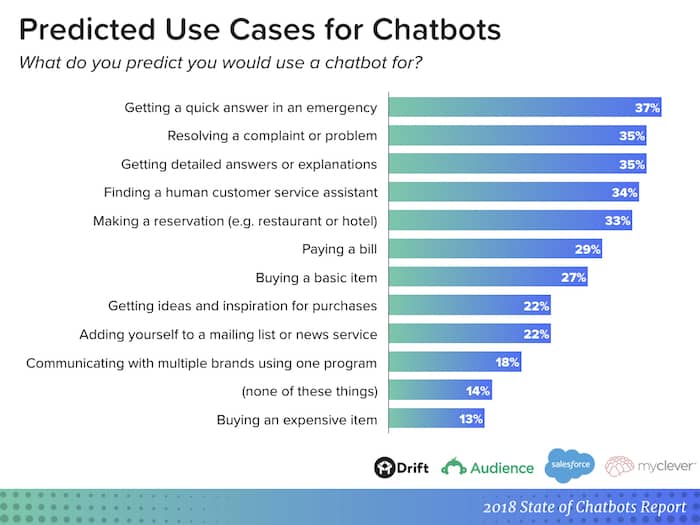
The most common predicted uses for chatbots that consumers reported included:
- Getting quick answers to questions in an emergency (37%)
- Resolving a complaint or problem (35%)
- Getting detailed answers or explanations (35%)
It’s also worth noting that 34% of consumers predicted that they’d use chatbots as a means to having a human conversation & human interaction.
The takeaway: There’s alignment between consumers’ frustrations and their predicted use cases for chatbots. Consumers want to be able to use chatbots to surface information and get answers quickly and easily. And if a chatbot doesn’t have all the answers, consumers would like that chatbot to be able to connect them with a human.
Blockers to wider chatbot adoption
Despite the many uses and benefits that consumers predict chatbots will be able to provide, the mass adoption of chatbots isn’t a foregone conclusion.
Especially when you consider how new the technology is, it’s understandable that consumers would have some concerns.
So, we felt it was important for us to ask our survey participants the following question: What would stop you from using a chatbot?
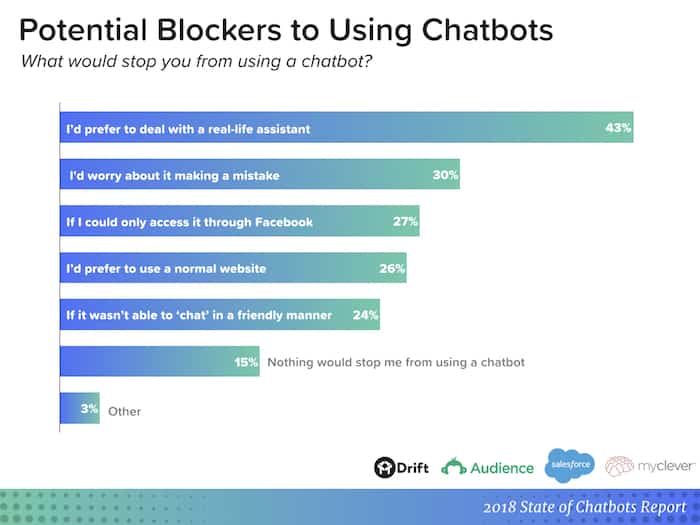
The most common potential blockers to using chatbots that consumers reported included:
- Preferring to deal with a human instead (43%)
- Worrying about the chatbot making a mistake, such as during a purchase or while making a reservation (30%)
- Being locked into using chatbots only through messaging platforms like Facebook Messenger (27%)
However, it’s also worth noting that 15% of consumers said nothing would stop them from using chatbots. And that figure was consistent across all age groups.
The takeaway: Not all consumers are ready to abandon human-to-human interactions entirely, and some aren’t sure they trust the technology to perform certain tasks without making mistakes. Also, if consumers could only access a chatbot through a specific social network, that could be a deterrent to adoption.
But here’s the thing: As a business, it doesn’t have to be either/or. You can use chatbot platforms where they make sense (e.g. for providing quick answers to simple questions) and then have humans step in when they’re needed.
What’s more, you don’t have to rely on Facebook Messenger bots in order to provide customers and potential customers with access to a chatbot. These days, you can have chatbots operating directly on your website, and you can use hyperlinks to make it easy for people to trigger chatbot conversations from any social network.
Chatbots vs. Other communication channels
While not all consumers are ready to trust chatbots entirely, most still acknowledge that chatbots are poised to provide several benefits that can enhance their online experiences. And it’s clear that one of the major benefits consumers see when it comes to using chatbots is speed: They believe that chatbots & conversational AI will be able to respond to their inquiries more quickly.
From a business perspective, there’s a massive upside to providing speedy response times. As research from InsideSales and the Harvard Business Review shows, even if you wait just five minutes to respond after a lead first reaches out, there’s a 10x decrease in your odds of actually getting in touch with that lead. After 10 minutes, there’s a 400% decrease in your odds of qualifying that lead.
So as part of our survey, we wanted to see how expected response times for chatbots compared to expected response times for other communication channels. The question we asked: How soon would you expect to get a response on each of these communication channels?
Response time by communication channel – more than 24 hours
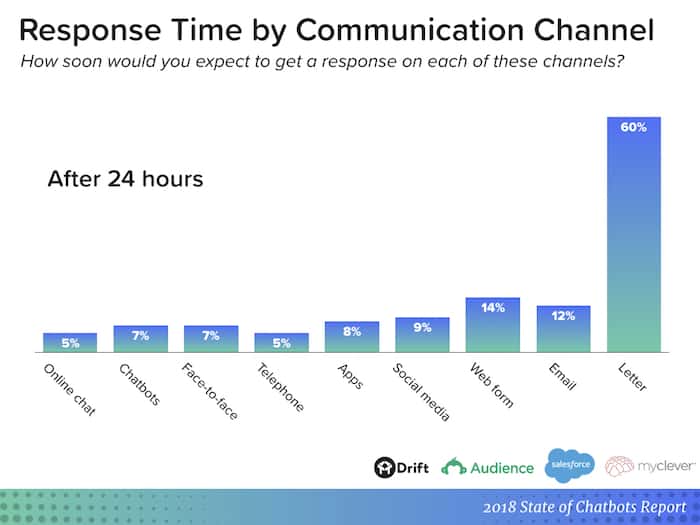
Response time by communication channel – less than 24 hours

Response time by communication channel – instant response expectations
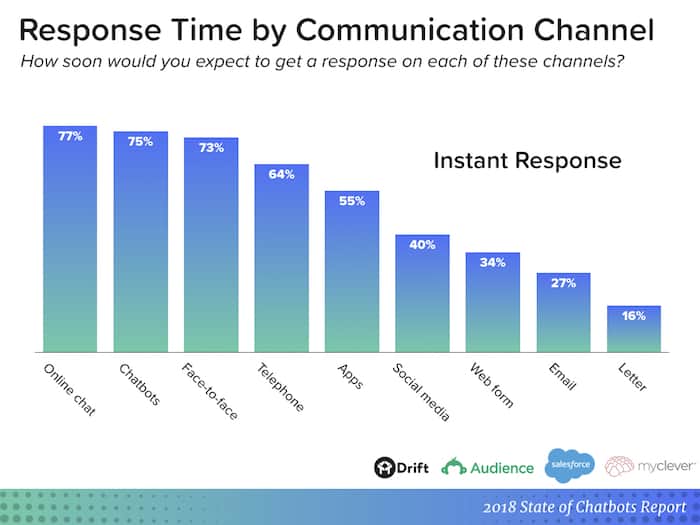
Ultimately, consumers expect to get instant responses from online chat more than any other channel (77%), but chatbots came in a close second (75%), and were followed by face-to-face meetings (73%).
Meanwhile, email (62%), landing page (web) forms (52%), and social media (50%), were the top channels when it came to expecting responses within 24 hours, and letters were far and away the number one channel when it came to expecting responses after 24 hours (60%).
The takeaway: Online chat is the channel that most consumers expect a real-time response from. However, chatbots came in a close second — higher than face-to-face, telephone, or apps.
And here’s something to consider: As an ecommerce business, by using live chat in combination with chatbots, you can deliver response times and resolve issues faster than ever before. When employees are online, they can take the lead in responding to incoming chats. But if chat volume gets too high, or if there are no employees online at the moment, chatbots can step in to assist so your response times don’t suffer.
In addition to looking at response times, we also wanted to see how chatbots compared to more traditional business communication channels in terms of perceived benefits. Specifically, we wanted to hone in on how chatbots compared to apps, email, and phone calls.
So we asked our survey participants: Which of these benefits do you most associate with communicating with businesses and organizations?
Chatbots vs. Apps

Chatbots vs. Email
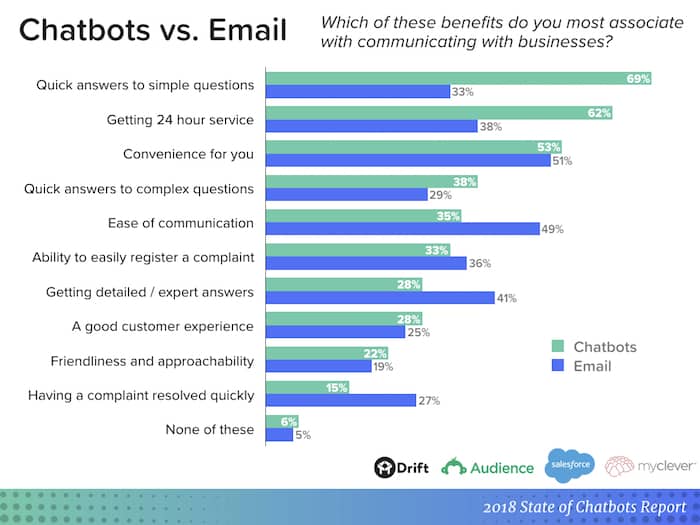
Chatbots vs. Mobile phone
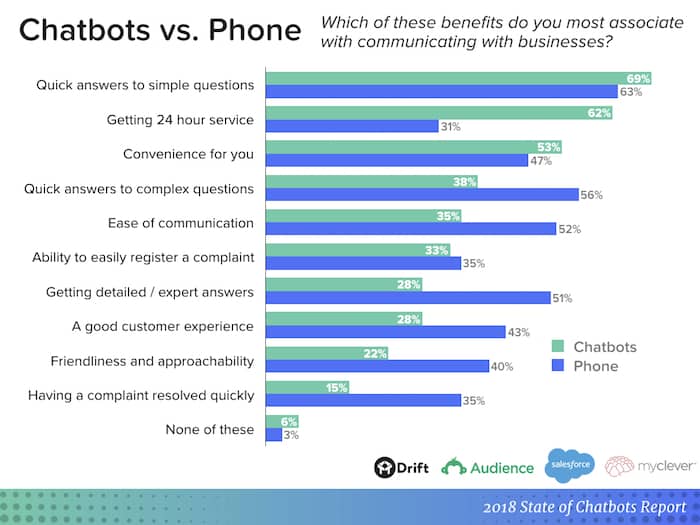
The Takeaway: Chatbots are the new apps, but they’ve yet to completely replace the need for phone and email when it comes to communicating with businesses.
Consumers preferred chatbots over apps in five of the ten benefit categories we looked at, which included not only getting quick answers to simple questions and 24-hours service, but also getting quick answers to complex questions and getting detailed/expert answers.
When it came to email, consumers once again preferred chatbots in the categories related to speedy response times (re: quick answers, 24-hour service). However, email had a definitive edge when it came to getting detailed/expert answers.
And it’s a similar story when we look at chatbots vs. phone calls, although in this case it’s notable that consumers also preferred using the phone for getting quick answers to complex questions. Email and phone were also considered superior when it came to ease of communication, as well as registering complaints and getting them resolved in a timely fashion.
One way businesses can make up for these perceived limitations of chatbots: Have chatbots give consumers the option of being able to send an email or schedule a call if that’s how they’d prefer to communicate. Because especially when dealing with complex technical issues, hopping on the phone with an engineer is likely going to be the better option.
While chatbots have a lot to offer in terms improving online experiences, they can’t replace the human touch.
Conclusion
These days, consumers expect to be able to find the information they’re looking for online quickly and easily. And when a business can’t provide that type of experience, they become frustrated. Chatbots are poised to ease these frustrations by providing the real-time, on-demand approach that consumers are seeking out.
The top three potential benefits of chatbots that consumers reported in our survey:
- 24-hour service (64%)
- Instant responses (55%)
- Answers to simple questions (55%)
And that’s true across all age groups. It’s not just Millennials who see the potential benefits of chatbots. In fact, Baby Boomers were 24% more likely to to expect benefits from chatbots in five of the nine categories we looked at compared to their Millennial counterparts.
However, chatbots — like all technologies — aren’t without their limitations: 43% of consumers said they prefer dealing with an actual person (that was the number one potential barrier to using chatbots). That being said, 34% of consumers also predicted that they would use chatbots for getting connected with a human. So it doesn’t have to be either/or. As a business, you can use chatbots to supplement your human workforce (not replace them).
Compared to other business communication channels, chatbots scored the second-highest when it came to consumers expecting instant responses, only losing out to online chat. But by using chatbots in combination with online chat, businesses can deliver a level of real-time service that they’d be unable to achieve using either technology on its own.
And while chatbots can’t replace phone or email when it comes to providing in-depth answers to technical questions (some things will always require a human touch), they are poised to become the new apps. As you saw in the previous section, chatbots outperformed apps in the following five benefits categories:
- Quick answers to simple questions (Chatbots, 69% | Apps, 51%)
- Getting 24-hour service (Chatbots, 62% | Apps, 54%)
- Quick answers to complex questions (Chatbots, 38% | Apps, 28%)
- Ability to easily register a complaint (Chatbots, 38% | Apps, 28%)
- Getting detailed / expert answers (Chatbots, 28% | Apps, 27%)
There’s been a lot of hype around chatbots recently, and ultimately, we see chatbots as a technology that can help bridge the gaps between business communication channels, and that can help deliver a better, speedier online experience to consumers.





























